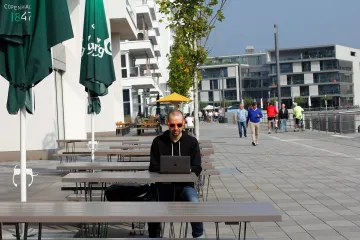
In early January last year, I wrote how remote working was going to be the next major trend in the way that we worked and technology like VoIP and the likes of Microsoft Teams was the key to seeing this trend progress over the 2020s. Well one global pandemic later we’re now in a situation where having faced a full year of lockdowns and being “out” of the office - that particular trend is now part of our day-to-day life, but not in the way anyone had anticipated.
Part of the perceived image problem with remote working was that it was seen as just something for small companies or some of the tech firms and that most firms couldn’t adapt to this way of working. The enforced nature of the lockdowns has meant that this theory was tested to the fullest – and found wanting. Adaptation is what humans do best - and when it came to it, the vast majority of (especially office-based) employees were able to work remotely without major impact to outputs.
 Why work from home when you can work from anywhere?
Why work from home when you can work from anywhere?
So, now that the remote working Genie is out of the bottle; and with the vaccine rollout on its way to us all over coming months, we are now looking at how the workplace will look when things do return to ‘normal’. Many of us look forward to getting back to seeing colleagues in the flesh, but according to a recent survey by Sigmar Recruitment of 250 Irish companies, only 34% of companies are looking at a full time return to the office – 22% are looking at full time remote working for staff and 44% are looking at some time in the office (two- or three-days a week) with the remaining two- or three-days remote working. (Note: there are those who are expecting a full return to a five day in the office week, but that seems now to be confined to those who don’t trust their staff - thankfully a trend on the wane - and some of those who develop/market office buildings (paywall) - a case of “well they would say that wouldn’t they” if ever there was one.
Even before the results of the survey came out, the hybrid model seemed to be the model that would work for most employers, staff and the environment (don’t forget we have carbon targets to meet!). So, what’s the best way to facilitate that particular model as we reopen the economy?
Quite simple really, look at the way you and your team are currently working, look at the reporting that you need to do in terms of metrics, look at your diaries (especially regular meetings) and look at the tech you are using.
And if you’re spending a lot of time on mobile calls as you sit at home in front of the laptop – your CFO (or inner CFO who wants to help with the bottom line and/or score a few brownie points) should be asking why? Integrations such as IPT for Teams (and its variants for Salesforce and Zoho) allow you to make and receive calls via your business phone system (you know the one that’s attached to all those deskphones in your office and gathering dust at the moment) from whatever device you have connected to the internet at home. And if you don’t use those particular CRMs – we have softphones and other integrations that allow you to do the same.
 Anytime, anywhere, from any device - the right tech enables flexible working
Anytime, anywhere, from any device - the right tech enables flexible working
So, you’re connected to the office whatever work model you choose going forward, no matter where you are - and there’s a whole set of call centre solutions we offer too but that’s a separate story. In terms of your diary, schedule in person meetings in the office when you need to, but also cluster them on the days that you are in the office. It’s important for teammates in particular to have some face-to-face time.
I did mention in the title that remote working and the hybrid office model is changing our cities and main streets. With the national broadband rollout in full flow, and VoIP adding the connection you need to be virtually part of the office - there’s no reason why we couldn’t work from home or walk to your local remote working hub and take a desk for the day (as a change of scenery, just as my colleague Tai did just before the pandemic struck).
 Remote working hubs are set to replace traditional offices
Remote working hubs are set to replace traditional offices
Economist and writer David McWilliams posted this tweet of Lower George’s street in Dun Laoghaire a day or so before I wrote this and asked us to imagine it pedestrianised. For the vibrancy that pedestrianisation needs to work you need people on the street during the day and if the vacant shops were converted to remote working hubs, the good folks of Dun Laoghaire could stroll down to their local hub for the day and log in to their own office (and their business phone system) from there rather than a commute. This then supports the cafes and shops on the street bringing the vibrancy that a town needs to thrive.
This could be replicated on every main street of Ireland, repurposing our historic buildings and breathing new life into our localities. Some existing office blocks, especially second generation or vacant premises may be repurposed for housing (similar to some of the developments close to where we are located out here in Parkwest). All of which, when coupled with the right technology based solutions, allows for greater sustainability in our environment and improved work/life balance overall.
Stay local – but this time enjoy it. Bring on the hybrid office.